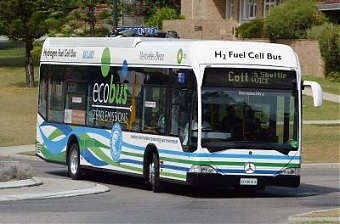Ecology, Energy, EU – Baltic States, Legislation, Transport
International Internet Magazine. Baltic States news & analytics
Saturday, 20.04.2024, 00:54
Fuel-cell buses: solution for city air pollution
 Print version
Print version |
|---|
Hydrogen-driven or fuel-cell buses
(FCEB) can use presently cost-effective shifts before being refuelled quickly
at bus depots; they are quiet and produce no carbon or particulate emissions,
thus minimising their environmental and health impacts.
The buses are powered by
electro-chemical cells that combine hydrogen stored in high pressure tanks with
oxygen from the air to generate electricity, heat and water. Performance
compares use more established diesel, trolley (tram) and battery bus
technologies, turning them into FCEB-like buses.
Managers for some transport projects,
e.g. Fuel Cells and Hydrogen Joint
Undertaking (FCH JU), which is a public-private partnership that is funding
research and demonstration projects, are seeking to enable the
commercialisation of fuel cell technologies.
These buses are clean, smooth and easy
to drive. Thus, a fuel cell bus can drive for 300-450 kilometers before it
needs to be refuelled, says an FCH JU report.
This gives the technology an edge over most established battery buses, which
have more limited ranges. And as they carry enough fuel on board for a full
shift, the buses need very little route infrastructure, unlike trolley buses
and some battery buses.
Capacity-building
The FCH JU now supports 67 of the
buses in Europe. It has published a call for proposals for a trial of at least
100 buses. Should this demonstration be successful, it will increase confidence
in investing in fuel cell bus fleets. Existing interest from bus operators
could expand Europe’s fleet to over 500 buses, with a potential European market
worth €1.5 billion.
Some predict that fuel cell buses
could catch up to battery bus production and technical levels in 5-10 years.
Europe has achieved a leadership status worldwide because of bringing the
demand and supply sides together. These efforts could be the first step in
developing a fully competitive market using hydrogen-based zero-emissions urban
transport; the implications are enormous in terms of the environment, job
creation and economic development.
In the last 15 years, fuel cell buses have
improved greatly. Hydrogen fuel efficiency has increased threefold to around
8-9 kg H2/100 km, while refuelling times have more than halved to
under 10 minutes. However, only 91 fuel cell buses are operating in Europe, the
FCH JU estimates.
Fuel cell buses are not used widely in the EU
cities; part of the reason is that they are still a young technology. But bus
fleet operators are reluctant to invest in the new vehicles without concrete
evidence of the risks and returns involved, while low demand makes them
expensive to build and limits post-sales support.
To address these barriers, small-scale
demonstration trials of fuel cell buses have been taking place in commercial
fleets around the world and in the EU. These provide data on costs and good
operational practice, improve economies of scale and supply chains, give
operators a say on how to develop bus models, and raise public awareness of the
technology.
Key trials based in Europe include:
- CUTE. The first EU-funded trial, having started in 2003. It tested fleets of three buses in nine European cities over three years.
- This project extended small-fleet demonstrations to 10 cities on three continents, funding a total of 47 buses.
- High V.LO-City, HyTRANSIT and 3Emotion. These FCH JU-funded projects are trialling bigger fleets of around 20 buses in more cities.
These demonstration projects have been
successful with operators and passengers alike. For example, as part of CHIC, a
small fleet of eight fuel cell buses in London (UK) has operated along a busy
route popular with tourists. It has performed so well that the participating
transport company now intends to expand its hydrogen fleet.
About Highvlocity
The
High V.LO-City project aims at accelerating the integration of a new generation
of FCH buses (14 FC buses will be operating in Scotland (UK), Liguria (IT) and
Flanders (BE)) in public transport fleets by demonstrating the technical and
operational quality.
See in: http://highvlocity.eu/
As FCEB technology has matured, the industry and transit operators are increasingly seeing economics, as well as air quality, as drivers for deployment. As some say, “we are not talking about sustainability anymore; we are talking about saving money”.
U.S. Department of Energy shows that the average fuel economy of fuel cell electric buses is 1.4 times higher than conventional diesel buses. At the same time, political will is vital, as regulations and incentives are essential to accelerate the momentum for FCEB deployment.
See: http://blog.ballard.com/top-4-myths-about-hydrogen-powered-buses
Trials in cities around the world have demonstrated that fuel-cell passenger buses can cut emissions and noise pollution while providing good quality public transport. New EU-funded projects could double Europe’s fleet of hydrogen buses – reducing vehicle and infrastructure costs per bus to boost take-up of the technology.
https://ec.europa.eu/programmes/horizon2020/en/news/cleaner-urban-transport-hydrogen-buses
Useful links on the issue: = CHIC
CORDIS; = High
V.LO City CORDIS;
= HyTransit
CORDIS; = 3Emotion
CORDIS; = Videos.
See also: The Fuel Cells and Hydrogen
Joint Undertaking (FCH JU), and = “Environmentally
friendly, efficient electric motion - 3emotion”. In: http://www.3emotion.eu/.








 «The Baltic Course» Is Sold and Stays in Business!
«The Baltic Course» Is Sold and Stays in Business!

